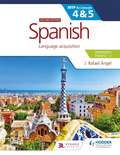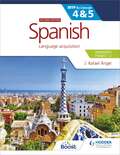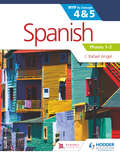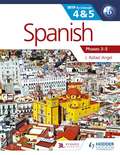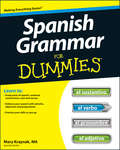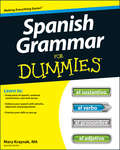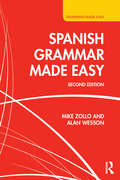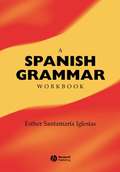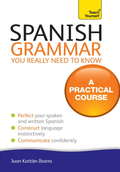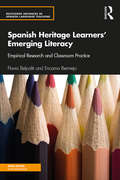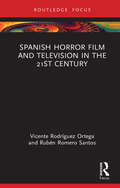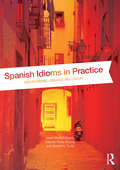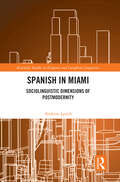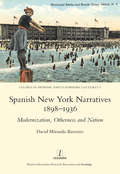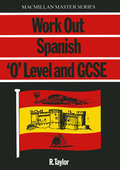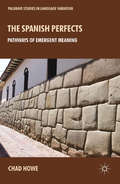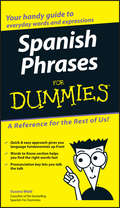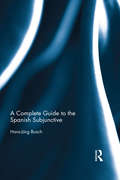- Table View
- List View
Spanish for the IB MYP 4&5 (Emergent/Phases 1-2) (Emergent/Phases 1-2) (Emergent/Phases 1-2) (Emergent/Phases 1-2): MYP by Concept Second edition: By Concept
by J. Rafael AngelDevelop your skills to become an inquiring learner; ensure you navigate the MYP framework with confidence using a concept-driven and assessment-focused approach to (insert subject), presented in global contexts.- Develop conceptual understanding with key MYP concepts and related concepts at the heart of each chapter. - Learn by asking questions for a statement of inquiry in each chapter. - Prepare for every aspect of assessment using support and tasks designed by experienced educators.- Understand how to extend your learning through research projects and interdisciplinary opportunities.- Think internationally with chapters and concepts set in global contexts.
Spanish for the IB MYP 4&5 (Emergent/Phases 1-2) (Emergent/Phases 1-2) (Emergent/Phases 1-2) (Emergent/Phases 1-2): MYP by Concept Second edition: By Concept
by J. Rafael AngelDevelop your skills to become an inquiring learner; ensure you navigate the MYP framework with confidence using a concept-driven and assessment-focused approach to Spanish, presented in global contexts.- Develop conceptual understanding with key MYP concepts and related concepts at the heart of each chapter. - Learn by asking questions for a statement of inquiry in each chapter. - Prepare for every aspect of assessment using support and tasks designed by experienced educators.- Understand how to extend your learning through research projects and interdisciplinary opportunities.- Think internationally with chapters and concepts set in global contexts.
Spanish for the IB MYP 4&5 Phases 1-2 (PDF)
by J. Rafael AngelEndorsed by the IBDrive meaningful inquiry through a unique concept-driven narrative.- Supports every aspect of assessment with opportunities that use the criteria- Gives you easy ways to differentiate and extend learning- Provides a meaningful approach by integrating the inquiry statement in a global context- Develops critical-thinking skills with activities and summative sections rooted in the ATL framework
Spanish for the IB MYP 4 & 5 (Phases 3-5)
by J. Rafael AngelDrive meaningful inquiry through a unique concept-driven narrative.
Spanish Grammar For Dummies
by Cecie KraynakThe tools you need to master Spanish grammar Spanish Grammar For Dummies is a logical extension and complement to the successful language learning books, Spanish For Dummies and 500 Spanish Verb For Dummies. In plain English, it teaches you the grammatical rules of the Spanish language, including parts of speech, sentence construction, pronouns, adjectives, punctuation, stress and verb tenses, and moods. Throughout the book, you get plenty of practice opportunities to help you on your goal of mastering Spanish grammar. Grasp the grammatical rules of Spanish Benefit from plenty of practice opportunities throughout the book Use the Spanish language confidently and correctly Whether you're a student studying Spanish or a professional looking to get ahead of the pack by learning a second language, Spanish Grammar For Dummies is your hands-on guide to quickly and painlessly master the written aspect of this popular language.
Spanish Grammar For Dummies
by Cecie KraynakThe tools you need to master Spanish grammar Spanish Grammar For Dummies is a logical extension and complement to the successful language learning books, Spanish For Dummies and 500 Spanish Verb For Dummies. In plain English, it teaches you the grammatical rules of the Spanish language, including parts of speech, sentence construction, pronouns, adjectives, punctuation, stress and verb tenses, and moods. Throughout the book, you get plenty of practice opportunities to help you on your goal of mastering Spanish grammar. Grasp the grammatical rules of Spanish Benefit from plenty of practice opportunities throughout the book Use the Spanish language confidently and correctly Whether you're a student studying Spanish or a professional looking to get ahead of the pack by learning a second language, Spanish Grammar For Dummies is your hands-on guide to quickly and painlessly master the written aspect of this popular language.
Spanish Grammar Made Easy
by Michael A. Zollo Alan WessonSpanish Grammar Made Easy is the ideal introduction to the basics of Spanish grammar for anyone new to the language or looking to refresh their knowledge. This second edition features: concise and jargon-free explanations supported by examples exercises throughout to reinforce learning a 'fast-track' option for more advanced learners a full answer key, making the Grammar ideal for self-study. A companion website is available at http://cw.routledge.com/textbooks/9781138955820. With over 200 additional exercises and audio, it provides ample grammar practice for learners as well as the opportunity to practise listening and pronunciation skills. Spanish Grammar Made Easy presents the essential patterns and rules of the Spanish language in a clear and accessible manner. It is the ideal Grammar for those wishing to supplement their learning and move beyond the phrasebook level.
Spanish Grammar Made Easy (Grammar Made Easy Ser.)
by Michael A. Zollo Alan WessonSpanish Grammar Made Easy is the ideal introduction to the basics of Spanish grammar for anyone new to the language or looking to refresh their knowledge. This second edition features: concise and jargon-free explanations supported by examples exercises throughout to reinforce learning a 'fast-track' option for more advanced learners a full answer key, making the Grammar ideal for self-study. A companion website is available at http://cw.routledge.com/textbooks/9781138955820. With over 200 additional exercises and audio, it provides ample grammar practice for learners as well as the opportunity to practise listening and pronunciation skills. Spanish Grammar Made Easy presents the essential patterns and rules of the Spanish language in a clear and accessible manner. It is the ideal Grammar for those wishing to supplement their learning and move beyond the phrasebook level.
A Spanish Grammar Workbook
by Esther Santamaría-IglesiasA Spanish Grammar Workbook contains 500 grammar exercises that vary in difficulty from simple tests and puzzles to multiple choice tests and realistic dialogues as well as communication exercises which function as prompts to the oral practice of the grammar in representative contexts. Includes 500 grammar exercises varying from simple tests and puzzles to multiple choice tests and realistic dialogues which contextualize Spanish grammar in everyday speech. Indicates difficulty level of each exercise and includes an extensive answer key. Complements and is cross-referenced with Blackwell's A Comprehensive Spanish Grammar by Jacques de Bruyne (with additional material by Christopher J. Pountain). Helps language learners understand grammatical functions naturally by putting theory into practice.
Spanish Grammar You Really Need To Know: Teach Yourself (Teach Yourself Language Reference)
by Juan Kattan-IbarraComprehensive and clear explanations of key grammar patterns and structures are reinforced and contextualized through authentic materials. You will not only learn how to construct grammar correctly, but when and where to use it so you sound natural and appropriate. Spanish Grammar You Really Need to Know will help you gain the intuition you need to become a confident communicator in your new language.
Spanish Heritage Learners' Emerging Literacy: Empirical Research and Classroom Practice (Routledge Advances in Spanish Language Teaching)
by Flavia Belpoliti Encarna BermejoSpanish Heritage Learners' Emerging Literacy: Empirical Research and Classroom Practice introduces a comprehensive, multi-level empirical study on the writing abilities of Spanish Heritage Learners at the beginner level; the findings guide a broad selection of instructional activities and pedagogical resources to support writing development in the heritage language classroom. This is the first book dealing exclusively with writing competence among Spanish Heritage Language Learners through the integration of empirical evidence and instructional perspectives to address core questions on heritage language literacy. In addition to the in-depth analysis of Spanish production—spelling, verb usage, grammatical features, vocabulary, and discourse organization—the volume revises the latest perspectives within the Heritage Language Education field, and provides effective teaching approaches, innovative classroom implementations, and up-to-date resources. This versatile volume, designed for researchers and practitioners in the fields of Bilingual Education, Language Teaching Methods, and Heritage Language Pedagogy, integrates empirical evidence, global perspectives on heritage language teaching, and suggestions for further research.
Spanish Heritage Learners' Emerging Literacy: Empirical Research and Classroom Practice (Routledge Advances in Spanish Language Teaching)
by Flavia Belpoliti Encarna BermejoSpanish Heritage Learners' Emerging Literacy: Empirical Research and Classroom Practice introduces a comprehensive, multi-level empirical study on the writing abilities of Spanish Heritage Learners at the beginner level; the findings guide a broad selection of instructional activities and pedagogical resources to support writing development in the heritage language classroom. This is the first book dealing exclusively with writing competence among Spanish Heritage Language Learners through the integration of empirical evidence and instructional perspectives to address core questions on heritage language literacy. In addition to the in-depth analysis of Spanish production—spelling, verb usage, grammatical features, vocabulary, and discourse organization—the volume revises the latest perspectives within the Heritage Language Education field, and provides effective teaching approaches, innovative classroom implementations, and up-to-date resources. This versatile volume, designed for researchers and practitioners in the fields of Bilingual Education, Language Teaching Methods, and Heritage Language Pedagogy, integrates empirical evidence, global perspectives on heritage language teaching, and suggestions for further research.
Spanish Horror Film and Television in the 21st Century (Routledge Focus on Media and Cultural Studies)
by Vicente Rodríguez Ortega Rubén Romero SantosThis book provides an up-to-date, in-depth survey of 21st-century Spanish horror film and media, exploring both aesthetics and industrial dynamics. It offers detailed analysis of contemporary films and TV series as well as novel approaches to key works within the history of Spanish cinema. While addressing the specificities of the Spanish landscape, this volume also situates the national cinematic output within the international arena, understanding film production and reception as continuously changing processes in which a variety of economic, social and cultural factors intervene. The book first analyzes the main horror trends emerging in the early 2000s, then approaches genre hybridization and the rise of new filmmakers since the 2010s with a special focus on gender issues and the reconfiguration of the past, before addressing the impact of streaming services within the Spanish film panorama, from a production and distribution standpoint. This book will be of keen interest to scholars and students in the areas of film studies, media studies, TV studies, horror, Spanish cultural studies and production studies.
Spanish Horror Film and Television in the 21st Century (Routledge Focus on Media and Cultural Studies)
by Vicente Rodríguez Ortega Rubén Romero SantosThis book provides an up-to-date, in-depth survey of 21st-century Spanish horror film and media, exploring both aesthetics and industrial dynamics. It offers detailed analysis of contemporary films and TV series as well as novel approaches to key works within the history of Spanish cinema. While addressing the specificities of the Spanish landscape, this volume also situates the national cinematic output within the international arena, understanding film production and reception as continuously changing processes in which a variety of economic, social and cultural factors intervene. The book first analyzes the main horror trends emerging in the early 2000s, then approaches genre hybridization and the rise of new filmmakers since the 2010s with a special focus on gender issues and the reconfiguration of the past, before addressing the impact of streaming services within the Spanish film panorama, from a production and distribution standpoint. This book will be of keen interest to scholars and students in the areas of film studies, media studies, TV studies, horror, Spanish cultural studies and production studies.
Spanish Idioms in Practice: Understanding Language and Culture
by Javier Muñoz-Basols Yolanda Pérez Sinusía Marianne DavidIdiomatic expressions are the ‘salt and pepper’ of any language. They give Spanish its colour and imagery, its richness and variety. From set phrases and idioms to metaphorical expressions and proverbs, these essential components allow users to add humour and spice to their language, vividly embodying Hispanic culture while naturalizing their communication style to more closely resemble that of native speakers. Key features: Includes a selection of the most widely used idioms from Spain and Latin America; Idioms are classified into specific and easy-to-reference categories; Creative activities, exercises, mnemonic devices and learning strategies facilitate the acquisition and mastery of idiomatic language; Connections between the Spanish language and Hispanic culture are explained and illustrated; Reference tables at the end of each section highlight similarities between English and Spanish usage of idiomatic language; Original samples, as well as fragments from various Spanish-speaking countries and well-known literary works, are included to help expose students to the use of idioms in journalistic and literary writing. Practical, informative and highly entertaining, this is the ideal text for all intermediate and advanced learners of Spanish.
Spanish Idioms in Practice: Understanding Language and Culture
by Javier Muñoz-Basols Yolanda Pérez Sinusía Marianne DavidIdiomatic expressions are the ‘salt and pepper’ of any language. They give Spanish its colour and imagery, its richness and variety. From set phrases and idioms to metaphorical expressions and proverbs, these essential components allow users to add humour and spice to their language, vividly embodying Hispanic culture while naturalizing their communication style to more closely resemble that of native speakers. Key features: Includes a selection of the most widely used idioms from Spain and Latin America; Idioms are classified into specific and easy-to-reference categories; Creative activities, exercises, mnemonic devices and learning strategies facilitate the acquisition and mastery of idiomatic language; Connections between the Spanish language and Hispanic culture are explained and illustrated; Reference tables at the end of each section highlight similarities between English and Spanish usage of idiomatic language; Original samples, as well as fragments from various Spanish-speaking countries and well-known literary works, are included to help expose students to the use of idioms in journalistic and literary writing. Practical, informative and highly entertaining, this is the ideal text for all intermediate and advanced learners of Spanish.
Spanish in Miami: Sociolinguistic Dimensions of Postmodernity (Routledge Studies in Hispanic and Lusophone Linguistics)
by Andrew LynchSpanish in Miami reveals the multifaceted ways in which the language is ideologically rescaled and sociolinguistically reconfigured in this global city. This book approaches Miami’s sociolinguistic situation from language ideological and critical cultural perspectives, combining extensive survey data with two decades of observations, interviews, and conversations with Spanish speakers from all sectors of the city. Tracing the advent of postmodernity in sociolinguistic terms, separate chapters analyze the changing ideological representation of Spanish in mass media during the late 20th century, its paradoxical (dis)continuity in the city’s social life, the political and economic dimensions of the Miami/Havana divide, the boundaries of language through the perceptual lens of Anglicisms, and the potential of South Florida—as part of the Caribbean—to inform our understanding of the highly complex present and future of Spanish in the United States. Spanish in Miami will be of interest to advanced students and researchers of Spanish, Sociolinguistics, and Latino Studies.
Spanish in Miami: Sociolinguistic Dimensions of Postmodernity (Routledge Studies in Hispanic and Lusophone Linguistics)
by Andrew LynchSpanish in Miami reveals the multifaceted ways in which the language is ideologically rescaled and sociolinguistically reconfigured in this global city. This book approaches Miami’s sociolinguistic situation from language ideological and critical cultural perspectives, combining extensive survey data with two decades of observations, interviews, and conversations with Spanish speakers from all sectors of the city. Tracing the advent of postmodernity in sociolinguistic terms, separate chapters analyze the changing ideological representation of Spanish in mass media during the late 20th century, its paradoxical (dis)continuity in the city’s social life, the political and economic dimensions of the Miami/Havana divide, the boundaries of language through the perceptual lens of Anglicisms, and the potential of South Florida—as part of the Caribbean—to inform our understanding of the highly complex present and future of Spanish in the United States. Spanish in Miami will be of interest to advanced students and researchers of Spanish, Sociolinguistics, and Latino Studies.
Spanish New York Narratives 1898-1936: Modernization, Otherness and Nation
by David Miranda-BarreiroIn the early decades of the twentieth century, New York caught the attention of Spanish writers. Many of them visited the city and returned to tell their experience in the form of a literary text. That is the case of Pruebas de Nueva York (1927) by Jose Moreno Villa (1887-1955), El crisol de las razas (1929) by Teresa de Escoriaza (1891-1968), Anticipolis (1931) by Luis de Oteyza (1883-1961) and La ciudad automatica (1932) by Julio Camba (1882-1962). In tune with similar representations in other European works, the image of New York given in these texts reflects the tensions and anxieties generated by the modernisation embodied by the United States. These authors project onto New York their concerns and expectations about issues of class, gender and ethnicity that were debated at the time, in the context of the crisis of Spanish national identity triggered by the end of the empire in 1898.
Spanish New York Narratives 1898-1936: Modernization, Otherness and Nation
by David Miranda-BarreiroIn the early decades of the twentieth century, New York caught the attention of Spanish writers. Many of them visited the city and returned to tell their experience in the form of a literary text. That is the case of Pruebas de Nueva York (1927) by Jose Moreno Villa (1887-1955), El crisol de las razas (1929) by Teresa de Escoriaza (1891-1968), Anticipolis (1931) by Luis de Oteyza (1883-1961) and La ciudad automatica (1932) by Julio Camba (1882-1962). In tune with similar representations in other European works, the image of New York given in these texts reflects the tensions and anxieties generated by the modernisation embodied by the United States. These authors project onto New York their concerns and expectations about issues of class, gender and ethnicity that were debated at the time, in the context of the crisis of Spanish national identity triggered by the end of the empire in 1898.
The Spanish Perfects: Pathways of Emergent Meaning (Palgrave Studies in Language Variation)
by L. HoweThis book considers the role of cross-dialectal data in our understanding of linguistic variability, focusing on the widely discussed dichotomy between past tense forms and relying primarily on spoken language data from different varieties of Spanish.
Spanish Phrases For Dummies
by Susana WaldThe fun and easy way to speak Spanish With Mexico the #1 international destination for Americans, over 14 million secondary school students enrolled in Spanish classes, and Spanish the primary language in many neighborhoods from L.A. to Miami, this should easily be the most popular title in our new phrase book series, following in the footsteps of Spanish For Dummies (0-7645-5194-9), which has sold more than 300,000 copies. Susana Wald is a writer, teacher, and translator.
The Spanish Subjunctive: A Reference for Teachers
by Hans-Jorg BuschA Complete Guide to the Spanish Subjunctive is the most complete reference guide to the use of the subjunctive in Spanish. Along with an exhaustive review of published literature on the subjunctive, the book also includes a thorough discussion of the uses and meanings of the subjunctive as well as examples throughout drawn from linguistic corpora such as the CREA database. The book presents a comprehensive theory of the subjunctive and provides practical rules for understanding, teaching and acquiring the Spanish subjunctive. This book includes: "Your Turn" sections that invite readers to reflect on the content discussed and on their own experiences in teaching the subjunctive A "Synopsis" section that summarizes the content of the work and offers practical suggestions for teaching the subjunctive Two indexes providing a summary of verb conjugation in the subjunctive and an alphabetical list of expressions used with the subjunctive.
The Spanish Subjunctive: A Reference for Teachers
by Hans-Jorg BuschA Complete Guide to the Spanish Subjunctive is the most complete reference guide to the use of the subjunctive in Spanish. Along with an exhaustive review of published literature on the subjunctive, the book also includes a thorough discussion of the uses and meanings of the subjunctive as well as examples throughout drawn from linguistic corpora such as the CREA database. The book presents a comprehensive theory of the subjunctive and provides practical rules for understanding, teaching and acquiring the Spanish subjunctive. This book includes: "Your Turn" sections that invite readers to reflect on the content discussed and on their own experiences in teaching the subjunctive A "Synopsis" section that summarizes the content of the work and offers practical suggestions for teaching the subjunctive Two indexes providing a summary of verb conjugation in the subjunctive and an alphabetical list of expressions used with the subjunctive.
